Who Controls the User Experience? AMD’s Carrizo Thoroughly Tested
by Ian Cutress on February 4, 2016 8:00 AM ESTGaming Benchmarks: 3DMark and Rocket League
Due to timing we were only able to run a couple of gaming tests, namely parts of the 3DMark suite and our Rocket League test. A reminder of our systems, including their graphics:
| System Overview | ||||
| µArch | APU + GPU | Memory | Channel | |
| HP Elitebook 745 G2 | Kaveri | A10 PRO-7350B (19W) R6, 384 SPs, 533 MHz |
8 GB | Dual |
| HP Elitebook 745 G3 | Carrizo | PRO A12-8800B (15W) R7, 512 SPs, 800 MHz |
4 GB | Single |
| Toshiba Satellite E45DW-C4210 |
Carrizo | FX-8800P (15W) R7, 512 SPs, 800 MHz |
8 GB | Single |
| HP Pavilion 17z-g100 |
Carrizo | A10-8700P (15W) R6, 384 SPs, 800 MHz |
8 GB | Single |
| Lenovo Y700 | Carrizo | FX-8800P (15W) R7, 512 SPs, 800 MHz R9 385MX, 512 SPs, 900-100 MHz |
16 GB | Single |
One of the biggest issues we’ll see here is the effect of dual channel memory on gaming. The Kaveri system used has a chipset solution that supports dual graphics, but also two memory modules installed. The Carrizo systems either came pre-prepared with one module installed or do not support dual channel memory full stop. This latter point is the main kick in the teeth, especially for a company like AMD that prides itself on gaming – the issue here is down to pin compatibility between Carrizo and Carrizo-L. As the latter only supports single channel, an OEM will design one motherboard to support both platforms (whether they are used for both or not). If a motherboard supports Carrizo-L, then it will not ever support dual channel memory, and any Carrizo APU that is used will be crippled.
Technically the Lenovo Y700 gets around this (hands up if you ever see a Carrizo-L based Y700 please) by equipping the system with a discrete graphics card and disabling Crossfire, so this system will still ultimately win in our tests due to the discrete card. The downside of this augmentation is the higher power draw, which would matter if our Y700 sample had a battery (the retail units come with a 60 Wh battery).
3DMark
3DMark is Futuremark's premium software, developed to tax systems at various different performance levels. The software contains several benchmarks as a result, with some focusing more on smartphone use all the way up to 4K, quad-SLI systems with as many in-game and post processing effects as you can throw at it. The base test, Ice Storm, is actually a good indicator of GPU scaling performance, but we also test Cloud Gate, Sky Diver and Fire Strike to get a measure of all of our systems.
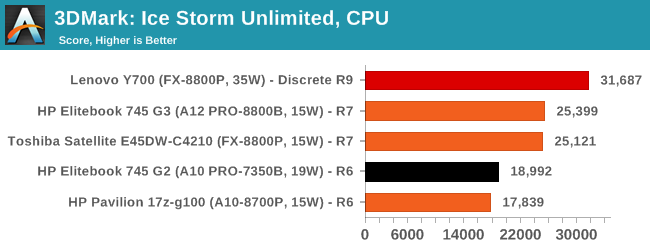
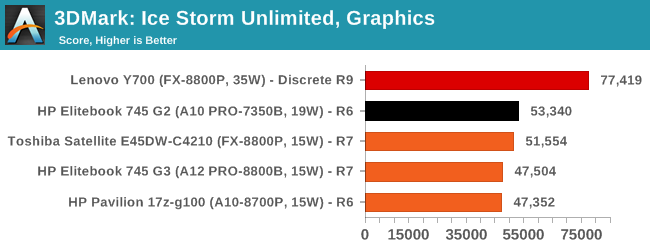
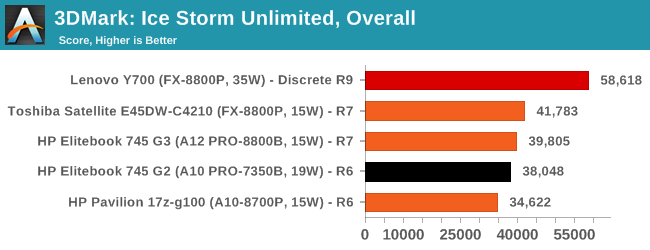
The easiest test, Ice Storm, shows the performance benefits of the Carrizo APUs in the CPU stage, although the dual channel memory for the Kaveri kicks in and gives it the graphics lead. The overall scores however benefit from that high CPU boost, so Carrizo at 15W on single channel wins this round.

Moving up in difficulty to Cloud Gate puts dual channel Kaveri in the lead, although the Toshiba is holding on a bit with its higher thermal skin temperature limit.
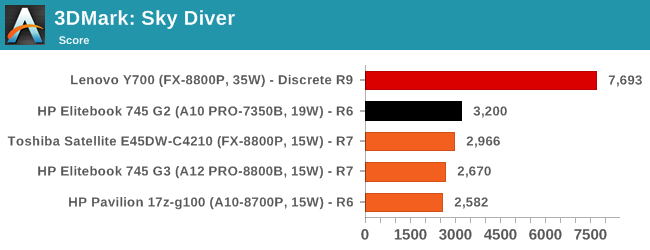
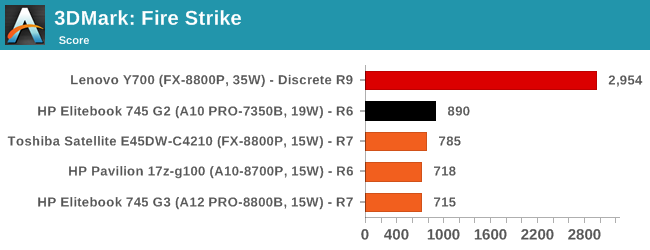
The last two benchmarks fall square with the dual channel configuration. The GDDR5 of the discrete graphics card in the Y700 wins out on all of them.
Rocket League
Hilariously simple pick-up-and-play games are great fun. I'm a massive fan of the Katamari franchise for that reason — passing start on a controller and rolling around, picking up things to get bigger, is extremely simple. Until we get a PC version of Katamari that I can benchmark, we'll focus on Rocket League. Rocket League combines the elements of pick-up-and-play, allowing users to jump into a game with other people (or bots) to play football with cars with zero rules. The title is built on Unreal Engine 3 and it allows users to run the game on super-low-end systems while still taxing the big ones. Since the release earlier in 2015, it has sold over 5 million copies and seems to be a fixture at LANs and game shows.
With Rocket League, there is no benchmark mode, so we have to perform a series of automated actions. We take the following approach: Using Fraps to record the time taken to show each frame (and the overall frame rates), we use an automation tool to set up a consistent 4v4 bot match on easy, with the system applying a series of inputs throughout the run, such as switching camera angles and driving around. It turns out that this method is nicely indicative of a real bot match, driving up walls, boosting and even putting in the odd assist, save and/or goal, as weird as that sounds for an automated set of commands. To maintain consistency, the commands we apply are not random but time-fixed, and we also keep the map the same (Denham Park) and the car customization constant. We start recording just after a match starts, and record for 4 minutes of game time, with average frame rates, 99th percentile and frame times all provided. For these tests, we used the 1280x720 resolution at high settings. A bigger explanation of testing can be seen in our AMD A8-7670K APU review.

Built on UE3 and DX9, the game relies heavily on single threaded performance and at this level of detail, memory bandwidth. The Kaveri takes the crown, showing that at this level adding another stick of memory (and making sure you have the right configuration) is more important than a more advanced (or perhaps expensive) APU.
We’ll go into temperatures on the next page.















175 Comments
View All Comments
basicmath - Tuesday, February 9, 2016 - link
No it's really not, this laptop came from the factory with dual channel capability but that capability was not utilised because that would have shown the platform in a much better light, he even states that he checked the chips in the G2 to confirm that it was single channel. Upgrading the RAM on a laptop is a simple process that any end user can perform. The only discernible difference between the APU in the G2 & G3 is the number of GPU cores so why did he even bother testing the G3 without using dual channel configuration?Intel999 - Sunday, February 7, 2016 - link
@IanI look forward to that R-series test as it will provide a sneak peek at how much DDR4 relieves the bottleneck on integrated graphics when Bristol Ridge comes out.
That $70 Athlon X4 845 is intriguing as well.
AS118 - Saturday, February 6, 2016 - link
Good article (although to be fair, I mostly skimmed it), and I agree with the conclusions. AMD should try harder to make sure their high-end products are paired with good components. Single-channel ram, bad screens, and slow hard drives with an A10 or mobile FX defeats the purpose of having those higher end APU's.Plus, people will get a bad impression of AMD if a lot of them have poor trackpads, etc. I wish they'd make their own "signature" brand of laptops, and find someone to help make them a thing.
TheinsanegamerN - Thursday, February 11, 2016 - link
Both clevo and MSI have treated AMD well before, Im sure either would love to have exclusive rights to the high end AMD notebook.That being said, I doubt AMD has the intelligence to pull it off. They seem to be run by monkeys 90% of the time.
Cryio - Saturday, February 6, 2016 - link
I'm really sorry for AMD. Kaveri and Carizzo on mobile, when configured to the proper ram, cooling and when using the highest performing part ... would've provided awesome performance, compared to Haswell and Broadwell. But no one bothered.Bristol Ridge will basically be Carizzo with DDR4 support and since it will be even better binned 28 nm CPUs, maybe we'll get even higher frequency out of Excavator. As for GCN 2.0 GPUs ... it will be interesting to see.
I love my Surface Pro 4, even given the disaster that is Skylake drivers and Windows 10 horrible efficiency compared to W8.1. But MAN. I would've loved a proper Carrizo based Surface Pro/Book.
Gadgety - Saturday, February 6, 2016 - link
A confirmation, with in depth detail. Nice write up.Khenglish - Sunday, February 7, 2016 - link
I would have really liked to see some dual channel results, or at least pulling a memory stick from the Kaveri and Intel systems to get a fair comparison. AMD says Zen brings a 40% IPC improvement. It'd be great to have a baseline to see if that 40% improvement is enough. In the dual channel intel to single channel AMD comparisons it does not appear to be enough, but we don't know how big of a factor memory was.Jon Irenicus - Sunday, February 7, 2016 - link
I want to buy an amd part for my next notebook but as was mentioned in the article, oems only choose bargain basement platforms to put the amd inside. The elitebook is the one exception, along with the lenovo if you don't mind the bulk.But the elitebooks are super overpriced for what you get. They need to release an hp spectre version of a notebook with a zen apu, a dell xps notebook variant with an apu. Ideally, the models that include a discreet gpu should allow the apu to work in tandem.
In 2017 dx12 will be in full effect with games, and having two gpus working together by default could give a lot of amd equipped systems a larger edge, especially if the oversized ipc deficits between excavator and intel parts is minimized with zen.
The future really does rest on Zen, amd needs to laser focus on performance per watt and ipc, and equip the 2017 apus with polaris gpu parts or vega or whatever the first iterations will be called. That has to be the minimum. Put those in nice chassis with solid battery life and that is all they need.
Intel999 - Sunday, February 7, 2016 - link
In DX12 dual graphics will be automatic. Even an Intel Igpu combined with a discrete Nvidia or AMD GPU will "merge" the graphic capabilities in the laptop.Theoretically, an AMD APU combined with an AMD GPU might have an advantage as all graphics would be from the same underlying graphic architecture. Time will tell if this bares out.
Ryan Smith - Monday, February 8, 2016 - link
Note that it's only going to be as automatic as the game developer makes it, as devs will be responsible for implementing it. For the moment game devs are going to be the wildcard.